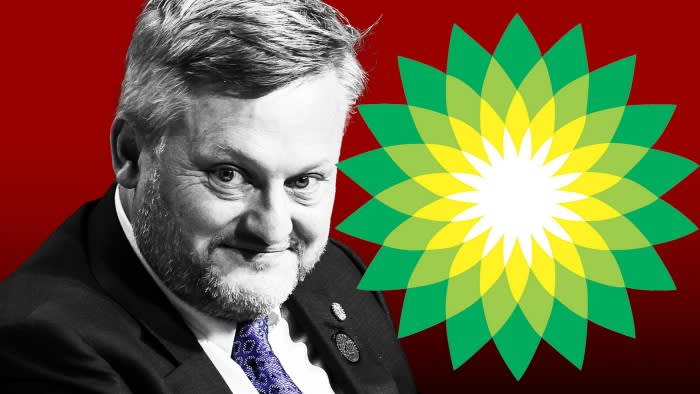
Murray Auchincloss is BP’s continuity candidate in more ways than one. The newly anointed chief executive officially takes charge of the oil major after months of being its caretaker in the wake of turmoil and scandal unleashed by the departure of his predecessor, Bernard Looney.
BP has never in its 114-year history recruited a CEO from outside the business. Auchincloss’s promotion this week means that the FTSE 100 company has stuck to that script. But is a safe pair of hands enough to narrow BP’s valuation gap to rivals that widened under Looney as he pushed the group into greener energy?
It is a strategy of which Auchincloss, is a key architect. The 53-year-old Canadian executive joined BP in 1998, served as chief financial officer from July 2020 and then as interim CEO, following the resignation of Looney in September over his failure to disclose past relationships with BP colleagues, some of whom he had later promoted.
In confirming that Auchincloss would permanently lead the business, BP had chosen the obvious and most straightforward option, analysts and investors said.
“On balance, the continuity candidate is probably what we looked for rather than a new broom coming in,” said one top 25 shareholder. “The reaction here is numbingly neutral.”
Looney announced plans in 2020 to transform BP from an oil and gas producer into an integrated energy provider by cutting fossil fuel production and investing in green technologies. Chair Helge Lund has said that BP and Auchincloss remain committed to the plan.
Auchincloss was “the best possible outcome for BP shareholders in the short term, as it represents continuity in the investment case”, said Biraj Borkhataria, an analyst at RBC Capital Markets. “An external candidate would have brought further uncertainty on the direction of the business and potentially more noise around another strategy shift.”
The challenge for the new chief is that shareholder returns under the strategy have been mixed and investor support varied.
BP’s trails its rivals Shell, TotalEnergies, ExxonMobil and Chevron in terms of total returns to shareholders over the past four years. It trades at approximately seven times its forecast 12-month earnings, compared with eight times for Shell and 11 times for Exxon and Chevron.
Prior to Looney’s sudden departure, there had been signs of progress. In February, Looney and Auchincloss slowed the group’s planned retreat from oil and gas and provided more clarity in an update on strategy on when and how BP’s five “transition” businesses — biofuels, convenience, charging, renewables and hydrogen — would generate meaningful earnings for the company.
BP’s shares rallied 10 per cent over the 48 hours after the news. Alongside Shell, it was the best performer of the five supermajors between January and August, in terms of total returns to shareholders.
But Looney’s departure, which rocked the company, and a poor set of third-quarter results, meant BP shares ended the year down 2 per cent, while Shell’s were up 11 per cent.
Addressing shareholders in Denver in October, Auchincloss, then interim chief executive, once again said the plan to transform into an “integrated energy company” remained unchanged but sought to provide greater clarity on long-term profits, lifting BP’s forecast earnings guidance for its oil and gas business in 2030.
“His priorities are delivering earnings growth, shareholder distributions and the balance sheet, rather than some additional pivot over and beyond last February,” said Oswald Clint, an analyst at Bernstein.
For now, although some shareholders — particularly in the US — would like to see BP row back further on its green strategy, other investors said they were seeking a period of calm after a tumultuous four months.
“I think in Murray we’ve got a safe pair of hands,” said one top 10 shareholder.
His appointment had been welcomed in part, analysts said, because after three years as CFO, Auchincloss was already known and well liked by many people in the market.
“Sometimes you just need someone in that seat who you are comfortable with,” said RBC’s Borkhataria. “Maybe you like the strategy, maybe you don’t, but at least you know the person and how they think.”
Announcing the appointment on Wednesday, Lund said the board had undertaken “a thorough and highly competitive” selection process, including consideration of external candidates. People with knowledge of the process said Lund, a former oil and gas chief executive at BG Group and Equinor, had always favoured promoting someone from within the business.
Lund joined the BP board in July 2018 and has been chair for five choppy years. In that position he oversaw Looney’s now-contentious appointment in 2019, the overhaul of BP’s strategy in 2020 and the response to the allegations about Looney’s past relationships in May 2022 and September 2023 that led to the chief executive’s departure.
The top 10 shareholder said Looney’s exit and the four-month gap before the confirmation of a permanent replacement was “unfortunate” but that he continued to back Lund, whose industry expertise was valuable to the business.
“It’s our role as shareholders to make sure the right corporate governance processes are followed but I don’t feel so strongly that I would be jumping up and down and demanding his resignation,” the shareholder said.
Auchincloss’s first test will come when BP reports its full-year results on February 6. After missing market expectations in October, a strong financial performance was needed to steady the ship, said Bernstein’s Clint.
“Hopefully we’ll see a good set of numbers and a continuation of the buyback and the stock will move the other way,” he said.
Additional reporting by Harriet Agnew in London


